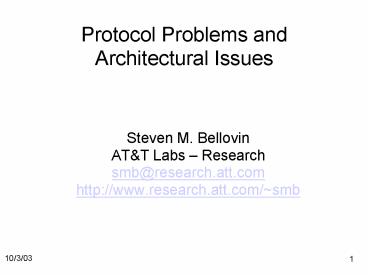Protocol Problems and Architectural Issues - PowerPoint PPT Presentation
Title:
Protocol Problems and Architectural Issues
Description:
Title: Protocol Problems and Architectural Issues Last modified by: Steven M. Bellovin Document presentation format: Custom Other titles: Times New Roman Bitstream ... – PowerPoint PPT presentation
Number of Views:61
Avg rating:3.0/5.0
Title: Protocol Problems and Architectural Issues
1
Protocol Problems and Architectural Issues
- Steven M. Bellovin
- ATT Labs Research
- smb_at_research.att.com
- http//www.research.att.com/smb
2
Different Kinds of Problems
- Directory versus lookup
- Surprising results
- Chokepoints
- Preemption
3
Directory Versus Lookup
- A directory provides an imprecise, often
interactive service - A lookup system provides reproducible,
predictable answers, suitable for use by programs - The DNS was designed to be the latter
4
Surprising Results
- Programs no longer do what you expect
- Sometimes there is incorrect behavior sometimes,
an error presents itself differently
5
Preemption
- The Internet empowers the endpoints, not the
middle - Endpoints applications, hosts, etc. can best
decide how to handle error cases such as
non-existent host name - Wildcards pre-empt that ability and put control
in the center
6
What is the Internet?
- TLD wildcards worked more-or-less adequately for
(most) Web work and ordinary email. - The IAB noted that wildcards in general are
mostly used for email only. - TLD wildcards do not work well for other
protocols. - What is the minimum common protocol set for the
Internet?
7
The Hourglass Model
- Historically, the Internet architecture has been
modeled as a hourglass Everything over IP, and
IP over everything. - Is the new model Everything over HTTP?
8
Today's Hourglass
App
App
App
TCP
UDP
...
IP
...
Ethernet
Wireless
9
Tomorrow's Hourglass?
App
App
App
HTTP
TCP
IP
...
Ethernet
Wireless
10
Where Do Services Originate?
- Most interesting new services come from the edges
- Often, neither the ISPs nor the IETF are
involved, most notably in the early days of the
Web. - One part of the center's job is to stay out of
the way of others' innovation we don't want to
lock in the Internet into the mostly-http model
11
Why Wildcards CanBreak Things
- The DNS does not know what application the user
wants - Is that an ancient mistake?
- It mirrors the division of responsibility between
IP and the upper layers - A service intended for one or two purposes will
often fail for other purposes. - Even normal services can be complex
12
Conclusions
- The Internet is built on a set of architectural
assumptions - This architecture encouraged innovation
- Breaking the architectural model will cause
unforseeable failures, both in less-common
existing software and for future ideas































